#20th c. orientalism
Text
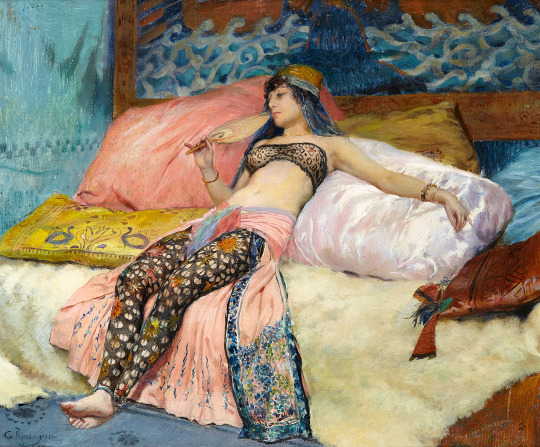
Portrait of Sarah Bernhardt (1844-1923) by Georges Antoine Rochegrosse (1859-1938)
#actress#sarah bernhardt#mdptheatre#stage costume#mdporient#20th c. orientalism#19th c. orientalism#orientalism
168 notes
·
View notes
Text

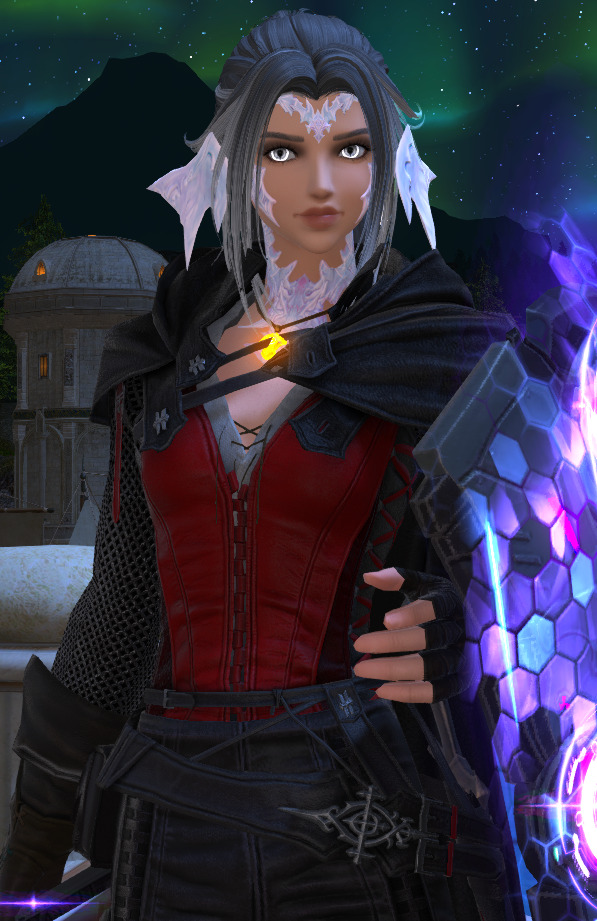
— B A S I C S
Name: Kirika Nanami
Nicknames: Kiri
Age: 26-ish
Nameday: 20th Sun of the 6th Astral Moon
Race: Au Ra, Raen
Gender: Female
Orientation: Biromantic demisexual
Profession: Warrior of Light
— P H Y S I C A L A S P E C T S
Hair: Naturally black, but after SHB it is now grey with white ends
Eyes: Red naturally, but grey with white rings of light after SHB.
Skin: White with opalite scales.
Tattoos/scars: No tattoos yet, but has some scarring on her torso and back from Stormblood, Shadowbringers, and Endwalker.
— F A M I L Y
Parents: Her father lives in Hingashi and is a wealthy warlord, while her mother died fighting for Doma during the first Garlean invasion.
Siblings: One brother named Kazuya.
Grandparents: Mother's side are dead, father's side are... not great.
In-laws and Other: Kazuya is ~single~
Pets: Momoko (chocobo), Saran (yol), and Ronin (amaro).
— S K I L L S
Abilities: SAM / SGE / PLD main (also very good at SUM, WHM, and BRD and is going to be switching to BRD for DPS main in Dawntrail :3c)
Hobbies: Traveling, reading, journaling, sketching, meeting new people.
— T R A I T S
Most Positive Trait: Loves deeply and selfless to a fault.
Most Negative Trait: Self sacrificing, stubborn.
— L I K E S
Colors: Red.
Smells: The sea, sakura flowers, sesame oil, campfires, fresh rice, kimchi, books.
Textures: Embroidery on silk, a specific kind of blanket made in Hingashi, flower petals, onsen water.
Drinks: Fruity wine, juices, cold spring water.
— O T H E R D E T A I L S
Smokes: Nah.
Drinks: Drinks socially, but doesn't like to be drunk.
Drugs: Nah
Mount Issuance: Most often rides her amaro in the First, and her Yol in the Source.
Been Arrested: Well, there was that time she got accused of regicide...
got tagged by @ardberts (ty!!!)
gonna tag @impossible-rat-babies, @coldvampire, @whynotsableye, @ottobooty aaaaand thats it for now jkfdsl
15 notes
·
View notes
Note
What's a ballet with real snazzy costume work, in your humble and/or professional opinion? c:
Oh, you’ve activated my trap card - asking about costume design and ballet and not expecting me to barf up the entirety of my PhD. I’ve also done work on the ballet blancs costumes (Giselle and La Sylphide specifically) but they are interesting on a theoretical level and not so much visually, so I’ll skip that.
So here are some personal favs of mine - the highlights, if you will. Caveat: long post, and mostly limited to the work of the Ballets Russes, because they are my longtime obsession and I think (and have argued) for their role in fundamentally changing stage and costume design (to say nothing of dance, and George Balanchine can sit the fuck down). I didn’t put that in my thesis but I wanted to.
Anyway tldr in the first decade of the 20th century a troupe of dancers from the Russian Imperial Ballet (later the Mariinsky) travelled through Europe under impresario Serge Diaghilev, for what became known as the Saisons Russes, or Russian Seasons. They performed both opera and ballet, and are probably best remembered today (if at all) as the troupe that danced the premier of Stravinsky’s Rite of Spring and caused a riot at the Theatre des Champs Elysées. The eminent artists that worked with them include Debussy, Cocteau, Picasso, Chanel - and these are only a few recognisable names. But my focus was primarily on the Russian roots of the ballet, in their visual language and presentation of gender and nationality, more precisely around the work of artist Leon Bakst and dancer Vaslav Nijinsky.
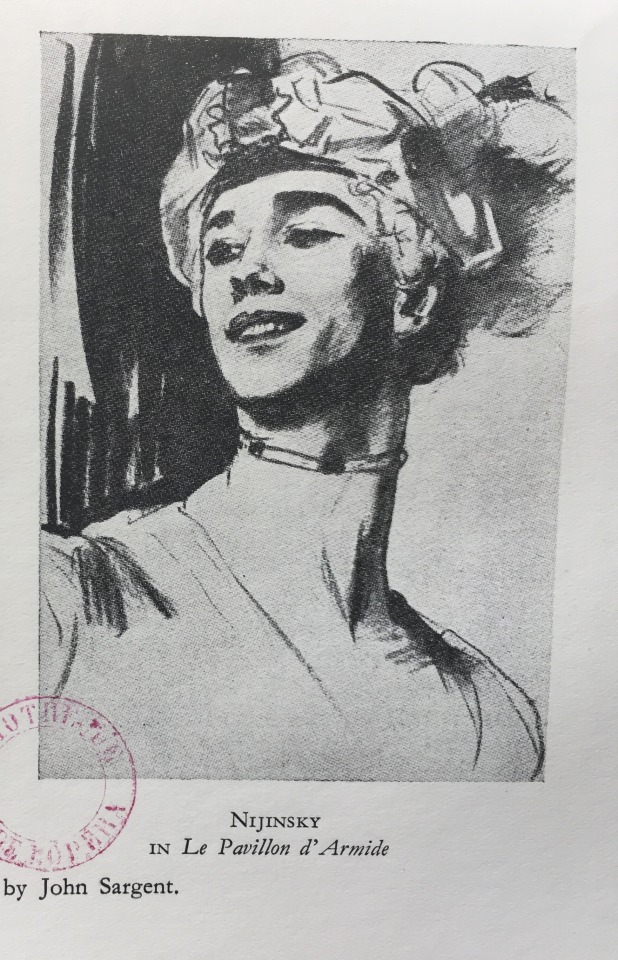
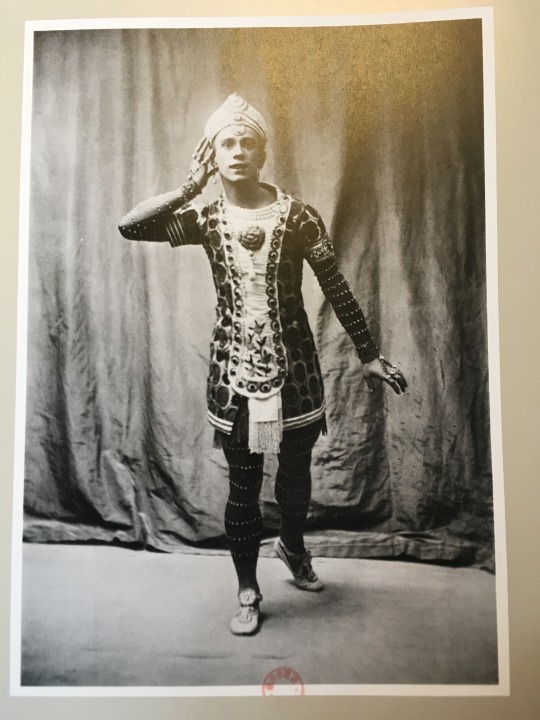
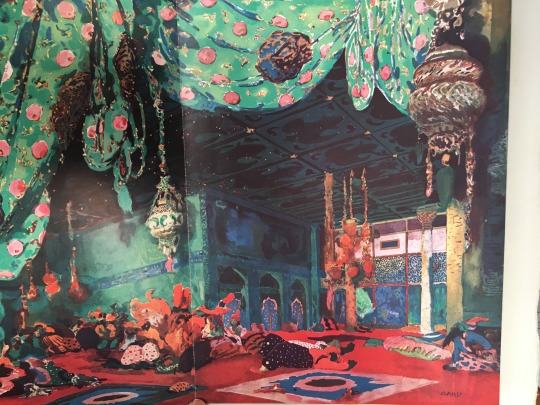
Second image of Nijinsky from Le Dieu Bleu, and Bakst’s set design from Scheherazade (1911). These are mainly photos and scans I have from the year I spent in the archives of the Palais Garnier (the Paris Opera) where all the good stuff is.
The crux of why these costumes are insanely interesting to me is because they are very specific to their time - they are a product of a resurgence in nationalist interests in Russian art (Diaghilev ran Mir Isskustva and worked with Savva Mamontov before he organised the BR) as well as a carefully crafted, highly artificial presentation of Otherness, expressly destined for export to the west. French audiences in the first decade of the 20th century (because there is a stark cut-off at the beginning of WW1) still had an appetite for Orientalism, despite their flagging colonial power. What the Russians brought them was compelling mix of performative Orientalism just vague enough to be appealing and fantastical, visually intriguing, and refreshing to a society that had otherwise come to recognise itself as decadent, fallen “victim” to modernity. In the athletic virtuosity of Russian bodies, Bakst’s exotic visual language and the soaring music of Rimsky-Korsakov and Stravinsky, the French devoured what they deemed a sort of noble savagery (yes, that kind). Despite the oversaturation of Orientalism in painting throughout the 19th century, the French identified a kind of masculine vigour and freedom in these live performances they found they themselves lacked, and longed for. Primitivism, as demonstrated in myriad ways by the BR, was for them a way to reconnect with a virility that they felt modernity had stolen, or at the very least, weakened. If you think this sounds eerily akin to the discourse around mounting desire for war to “cleanse” or “reset” Europe during that same period, you are right.
A few of Bakst’s lesser known designs from the archive, for context (including a reprod by Barbier which I don’t have the OG of but is saved in my Bakst folder so please take my word for it). I have a thousand more of these but tumblr has an image limit per post 😤

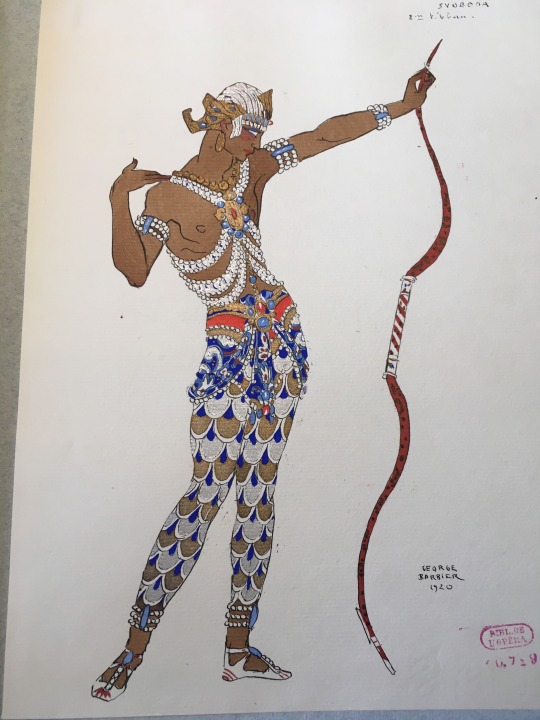

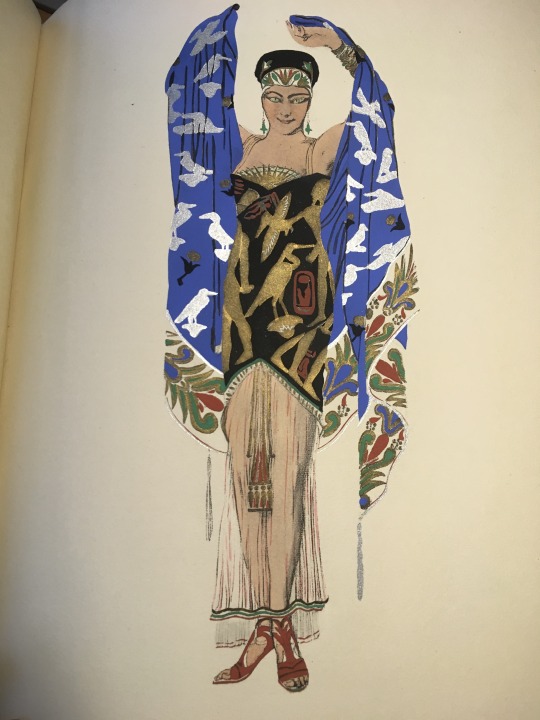

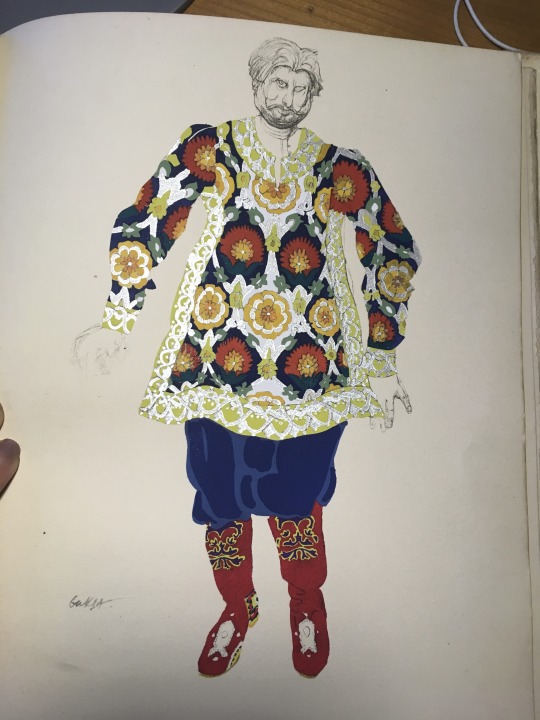
Tamara Karsavina, who often performed with Nijinsky, and one of my most beloved historical figures. The existence of a strong classical ballet cirruculumin the UK today is in part thanks to her.

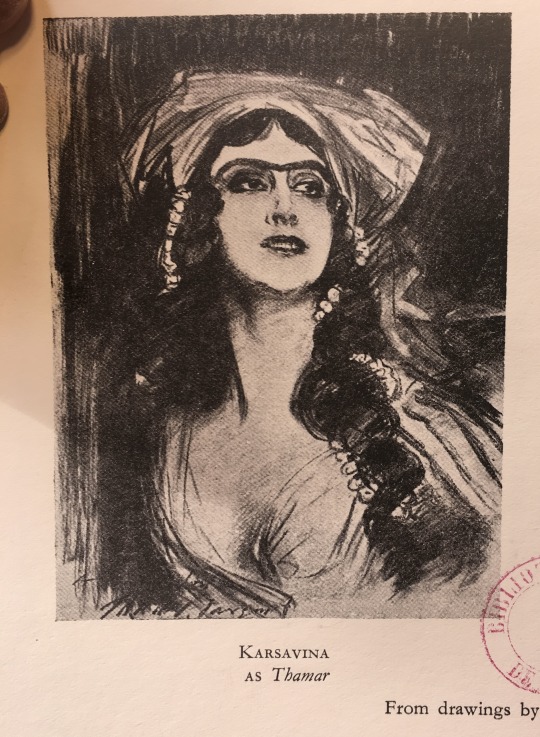
One of her most famous roles, as the Firebird:
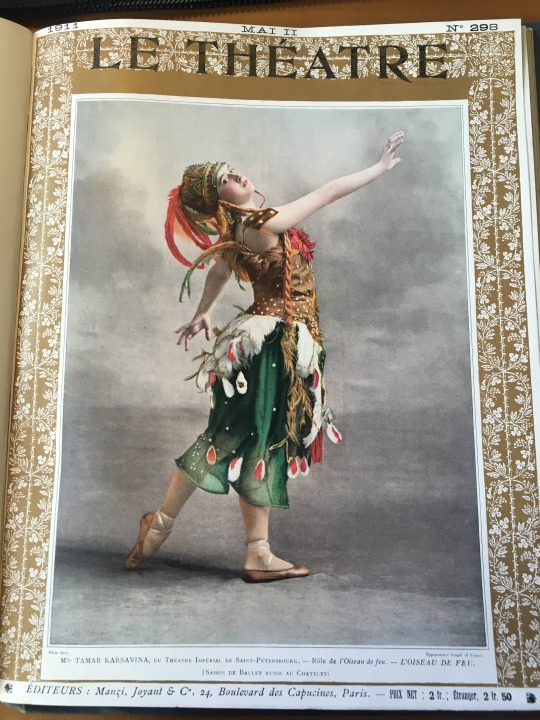
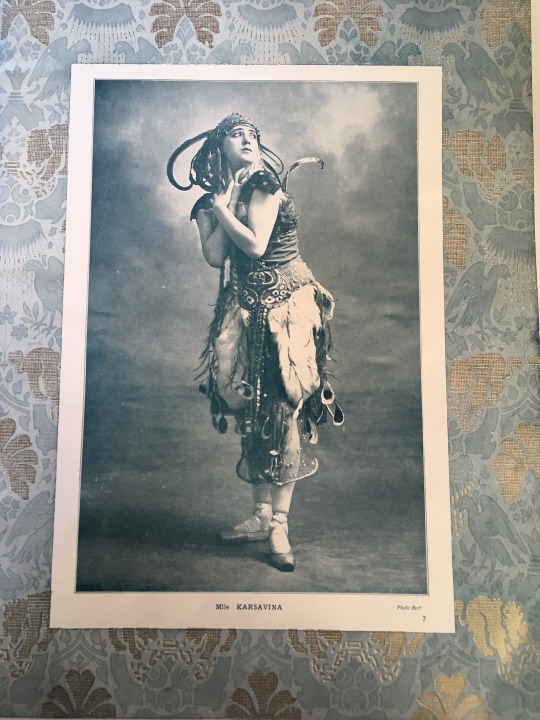
Nijinsky is by far the most interesting figure to come out of the BR. He combined virtuosity and strength (that most audiences identified as masculine) with a glittering, joyful, and expressive queerness on stage (and off). Some of his greatest roles are expressly feminine in their costume design: Le Spectre de La Rose, for example.
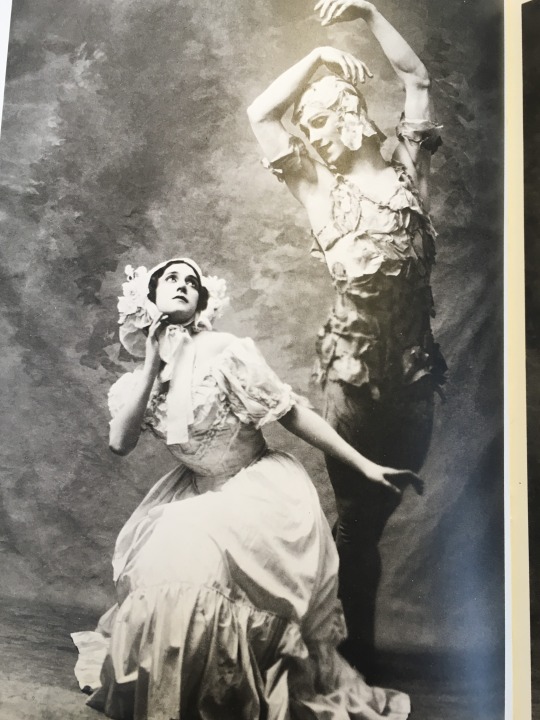
There’s a colorised version of this out there where you can see every pink rose petal on him.
While others are much more decorative but still markedly Orientalist (or Russian-Orientalist): Le Dieu Bleu, La Peri, Les Orientales, L’Oiseaux de Feu.

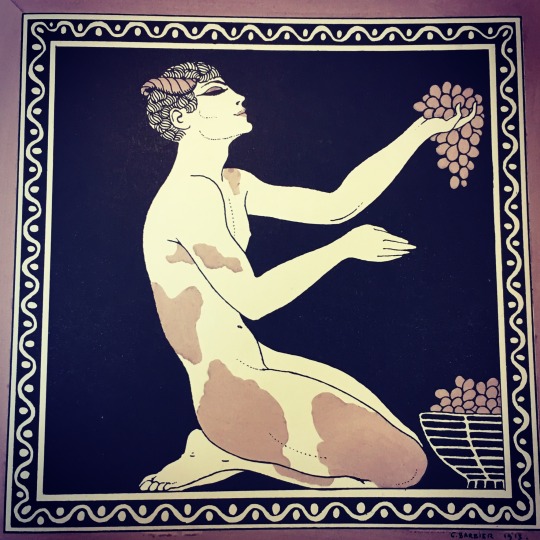
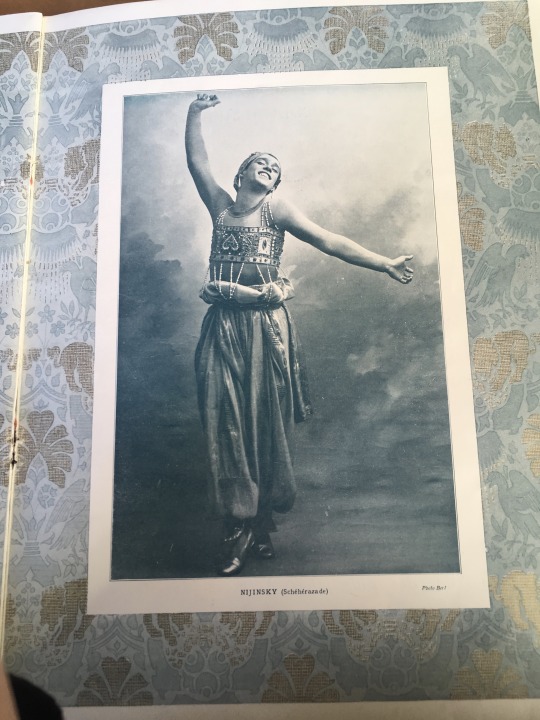

This last image above is not, the last I saw it, in a private collection. It hangs above the vestibule of the Palais Garnier archives (also Napoleon’s private hangout room) where it faces the sort of “diptych” version that features Karsavina, and on occasion I would stand below them and weep quietly).
Either way, there is an argument to be made about Nijinsky’s physicality and, more importantly nationality as a kind of avenue of permission through which the French could admire both his beauty and athleticism and even, to a degree, imagine themselves in his place while still maintaining that safe distance of Otherness.
But I would argue that his greatest role was the Golden Slave in Scheherazade, a wild, erotic orientalist fantasy that has little to nothing to do with the actual tale of Scheherazade. In it, Nijinsky - bejewelled, wild, ecstatic, (and yeah often in blackface) - cavorts with Zobeide, the Sultan’s favourite, in a very sexually explicit storyline. Both characters are equally decorative in their costumes, and both, in real life, were recognisably queer(ed) figures. It’s Scheherazade in particular that helped accelerate an obsessive trend in fashion (Paul Poiret was at the centre) for Orientalist design. Bakst himself did some silhouettes that are hard to distinguish from his costume design, and through the remarkable illustrations by Paul Iribe, Georges Lepape and Georges Barbier, we can see some of the blatant repetition of motif and silhouette in these ensembles that are designed, among other things, to be worn to the theatre.
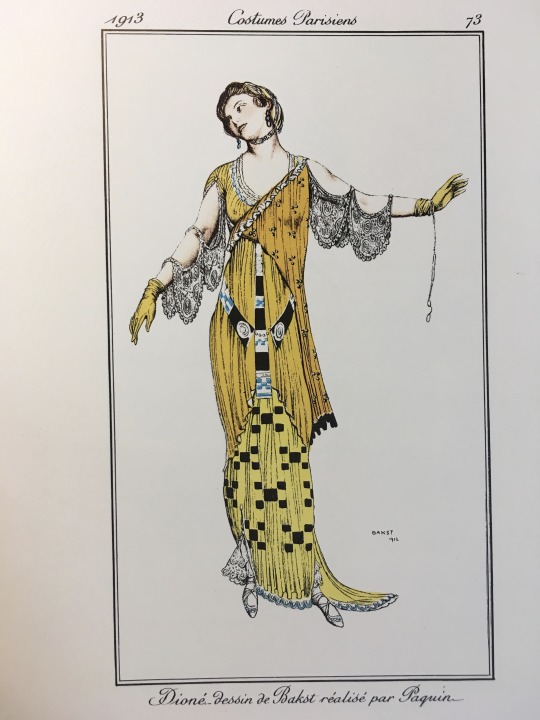
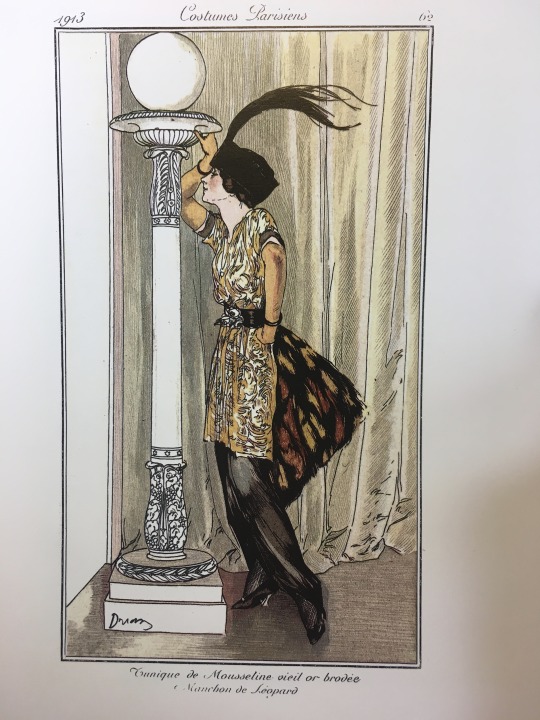
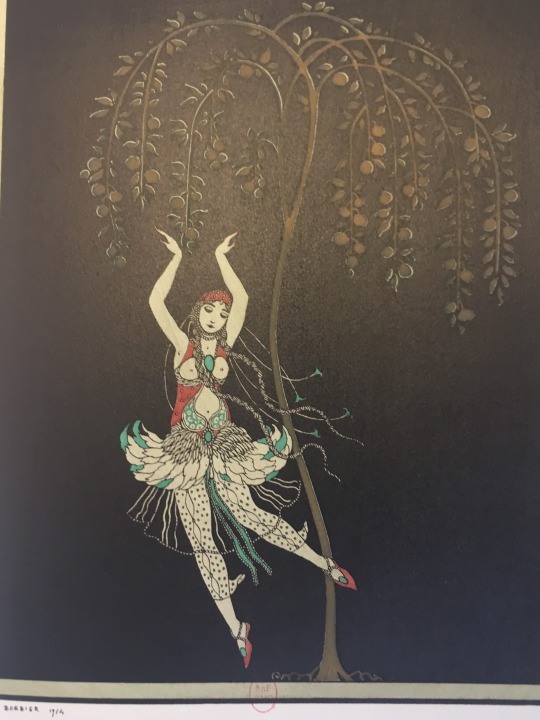
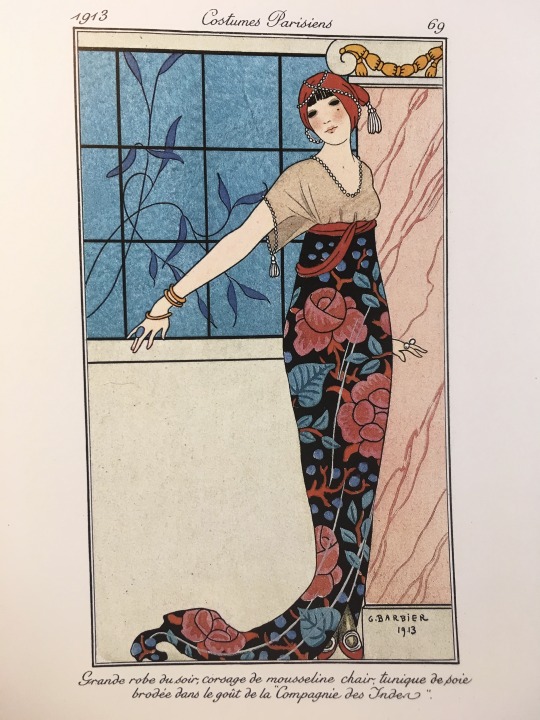
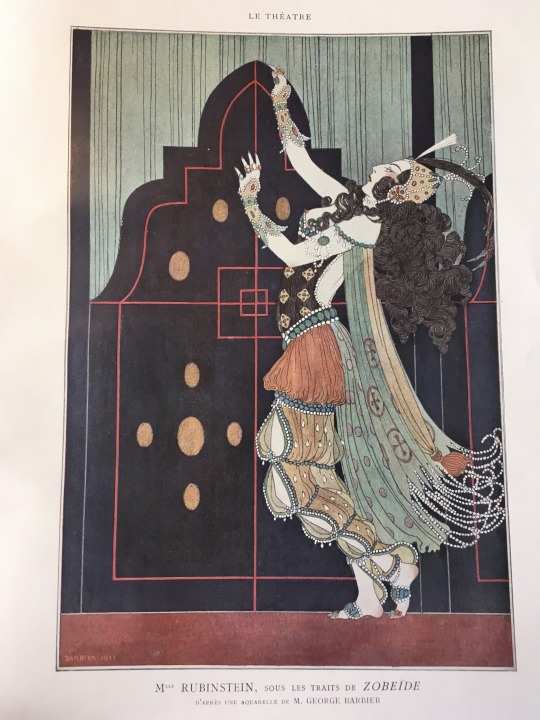
3rd and 5th are depictions of costumes of the Firebird and Zobeide respectively; the rest are fashion plates. This doesn’t even include the lampshade dress - which I don’t have a handy picture of, but have seen in real life - that is a pretty blatant melange of the Firebird and Zobeide, as designed by Poiret. Below is one of my favourite examples: A woman in a lampshade-style dress, standing against a backdrop not unlike Bakst’s set design above, attended by a archetypal oriental servant wearing Nijinsky’s Golden Slave costume.
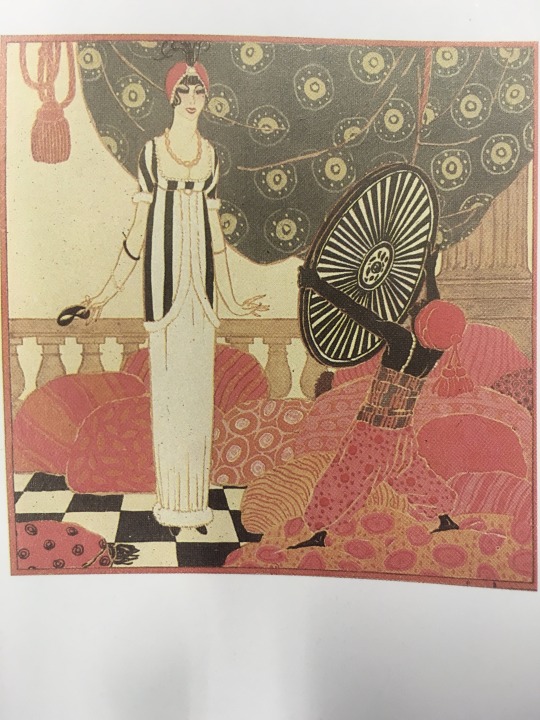
These motifs also proliferated in advertisements and in all kinds of other consumer products (perfumes, for example, and decorative objects). Thus, there’s a performative aim in wearing these designs that I read as a sort of pseudo-kinetic empathy (and can funnnily enough probably be compared to cosplay). There is an attempt here to channel what is being presented onstage, to reenact it, to physically embody it, in the way that fashion is, at its core, a tool through which to construct identity. That the French pulled inspiration from an openly queer man leaping across the stage dripping in jewels, and from femme fatal-style odalisques, says a lot about the visual and cultural impact the BR had on the theatre-going public at the time.
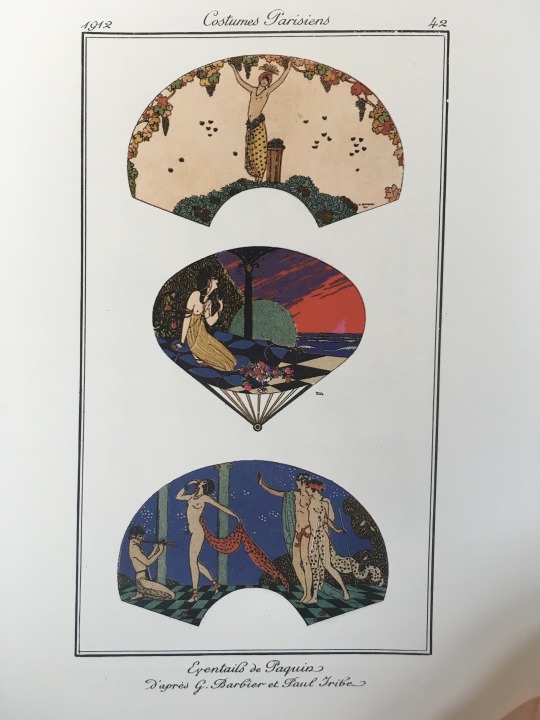
You can see in these fan designs by Paquin some pretty obvious references to the BR aesthetic: L’apres-midi d’un faune, Daphnis et Chloe, Scheherazade, even a little Le Pavillon d’Armide in that first one.
Nijinsky was not the only one to queer the stage: despite not being a dancer trained to the level of the BR troupe, Ida Rubinstein, no doubt purposefully channelling Sarah Bernhardt, was also a beloved stage presence, whether as the sly harem favourite Zobeide or as the strikingly androgynous St Sebastian, gayest of saints.

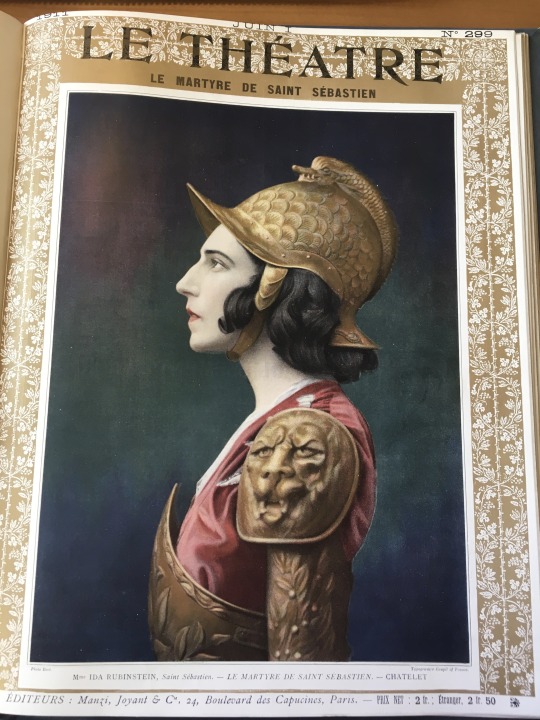
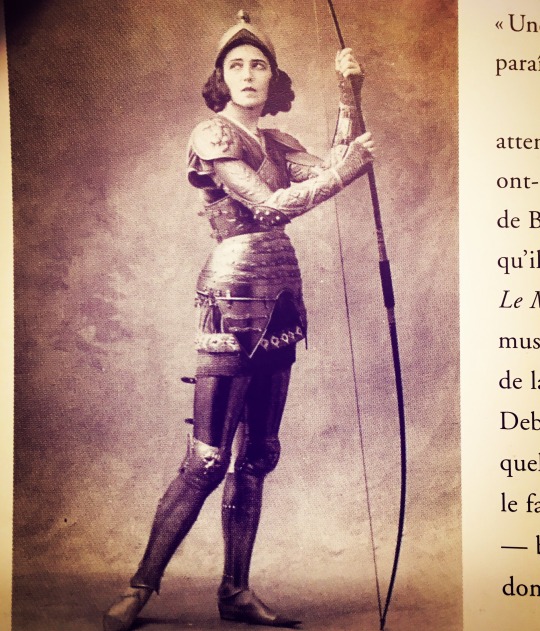
This is not to say there haven’t been wonderful and brilliant costume designs since - and quite a few known fashion designers working alongside dance companies, to great success or otherwise. I will, however, shoutout my favourite contemporary work: Akram Khan’s Giselle, which has everything and yet nothing to do with Adolph Adam’s 1842 piece. I don’t even want to post pictures because the costumes of the nobles (the landowners, in this very apocalyptically late-stage capitalist version) are so fucking breathtaking in relation to the overall design, and their entrance itself is probably one of the most spectacular parts of the ballet, that all I can say is just see it. Or buy the dvd. What Khan does gesturally is beyond words, what Vincenzo Lamagna does with Adam’s original score is visceral and haunting and churns my insides. I make a point to see it live at least once a season when it’s touring with the ENB, and I will do so until it leaves the repertory or until I die. It’s my contemporary Scheherazade. It’s a gesamtkunstwerk.
Tldr Leon Bakst is one of the greatest costume designers of the 19th and 20th century and criminally underrated.
It’s not ballet, and it’s not the sumptuous costumes from Boris Godunov, but as a bonus here’s my favourite image of opera star Fedor Chaliapine as Ivan the Terrible.
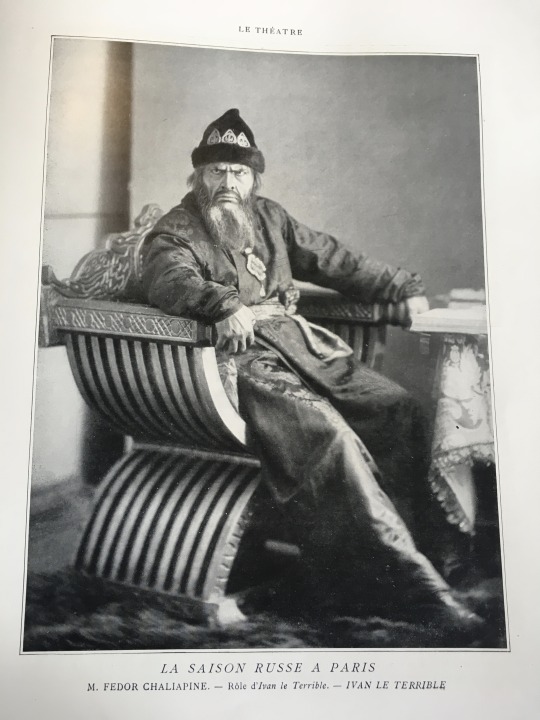
#Thank you for the enclosure enrichment#And for coming to the tldr of my thesis#ballets russes#vaslav nijinsky#Leon bakst#fashion design#academic indulgence hour#Art history
48 notes
·
View notes
Text
Gale Helvig

Full Name: Gale Helvig
Age: 27(?)yrs
DOB: March 20th ♓️
Species: Valkyrie
Height: 5'5" (165cm)
Weight: Approx. 145lbs
Blood Type: AB-
Occupation: Library Aid (day) Bar/Lounge Singer (evening)
Gender: Cis Femme
Orientation: Bisexual
Personality: Impulsive, generous, inquisitive, curious, perceptive, observant, affectionate, reactive, emotional, naive
Conditions: ADHD, Autism Spectrum, C-PTSD
Special Abilities: Flight (4 wings), superhuman strength/speed/endurance, strong eyesight (far), flexibility, flight based/arial combat
Bio: Gale is currently attending college for music (singing/opera) and musical theater. She is much out of her element, not having set foot in the mortal plane outside of war and battles, but she's learning as she goes!
Past: Gale is the child of a human (father) and Valkyrie (mother). She is not permitted to be a Valkyrie until after her mortal body dies, so she has been living a life in between the Valkyrie realm and the mortal realm. Being raised alternately by a human adoptive mother in the Sweedish wilderness and her Valkyrie sisters, her understanding of the mortal realm is biased and limited. She hopes that by living as a mortal and learning at their institutions, she may better connect with her human side.
Other References: (TO BE UPDATED W VALKYRIE FORM)

16 notes
·
View notes
Note
hi! would you mind explaining a little bit more about sexual inverts? i have been reading maurice and thinking of clive along similar lines, but i think i'm missing some of the context in not understanding 19th to early 20th century's views around sex. i don't really know where to start digging around either ehehehe.
also, if you have time, would you say that while we now think of sexuality and gender as separate, there is still an underlying understanding of sexual desire as comprising the sexes, perhaps in a general context, especially as it relates to heteronormaitivity? thank you~
sorry this took a minute i have gallstones maybe. sexual inversion appeared in medical literature starting in about the 1870s and was popularised more during about the 1920s. the theory was that homosexual desire was the result of normal sexuality located within a person who was constitutionally abnormal, specifically in the manner of mentally having the 'opposite' of their anatomical/genital sex (bisexual desire was thus configured as a kind of intersex/bi-sex position). so, inversion as formulated in this period relied on a notion of a strict human sexual dimorphism, specifically with the two accepted sexes configured as opposite to one another; sexual desire and behaviour were simply part of this configuration of sex. one important thing to note here is that inversion was embraced by some practitioners and homosexuals in an effort to shift away from the idea of homosexuality as a criminal choice and toward homosexuality as an inborn trait (though i would argue that this was not a wholly new idea, as plenty of medical and political discourses viewed criminality itself as an inborn moral defect throughout the 19th century). so, in the invert framework, a gay man had the 'soul' (/mind/desires/&c) of a woman, and vice versa with lesbians being in some sense 'men' internally. homosexual desires were conflated with, and part of a larger narrative of, cross-sex identification and gender nonconformity. crucially, the fact of this desire in itself was already a transgression of assigned sex/gender; thus, in some sense the invert framework really doesn't ontologically allow for, eg, a masc gay man, as the fact of gayness is already and always considered to be a gender deviation.
it's been a really long time since i read 'maurice' and i don't remember thinking of either of them as inverted, but i certainly could have missed that. forster wrote homosexuality as basically inborn and unchosen (hence the failure of maurice's hypnotist, and the quiet tragedy of clive's ending) so there may be some overlap/similarity there.
in the 21st century, gender expression and identity certainly still have a relationship to sexuality and sexual desire; for example, it's fairly common to hear from gay and bi people that even if they do continue to consider themselves cis, they feel some disconnect from their assigned genders in relation to their sexual orientations. the legacy of the invert theory is also part of the puzzle in terms of why transitioning used to be wholly prohibited in the us for trans people who would not be transitioning 'to be heterosexual'. although this is no longer part of the medical guidelines as articulated by wpath &c, there are certainly still plenty of doctors who hold this belief implicitly or explicitly, particularly in their 'evaluations' of trans women (ray blanchard's theory is maybe the most infamous example of this, but is certainly not its only manifestation). i would argue that for the most part, our conception of sex has shifted so much that the invert framework no longer makes sense in most contexts; even strict blanchardians believe on some level that sexuality is something besides a component of sex, and you can tell from how shittily they (and others) actually treat trans lesbians that they in fact do not see them as being equivalent to straight men, but as another category, without access to any of the social benefits men receive (this is a critical aspect of how transmisogyny functions). although sexuality is still part of how people are expected to act out their sexes (bc ofc sex is as socially constructed as gender), you would be hard-pressed to find anyone these days who would defend the argument that the origin of homosexual desire is a constitutional perversion of sex in the way that the invert framework describes. on tumblr at least, there have been some circles of t/erfs and cryptos who tried to 'reclaim' the invert framework but, i would argue, have never really understood what they were actually reclaiming and how it functioned historically, so the appeal was simply to the word "invert" with a peculiarly 21st-century content ascribed to it.
i'll leave some reading recs under a cut; sorry they're almost all british context:
sexual inversion: a critical edition, by havelock ellis and john addington symonds, ed. ivan crozier
'scholars, scientists, and sexual inverts: authority and sexology in nineteenth-century britain' by heike bauer (ch. in: repositioning victorian sciences: shifting centres in nineteenth-century scientific thinking, ed. david clifford)
'historicizing inversion: or, how to make a homosexual', by matt t reed (history of the human sciences, 2001, vol. 14, no. 4, pp. 1–30)
'theorizing female inversion: sexology, discipline, and gender at the fin de siècle', by heike bauer (journal of the history of sexuality, 2009, vol. 18, pp. 84–102)
'the origin of italian sexological studies: female sexual inversion, ca. 1870–1900', by chiara beccalossi (journal of the history of sexuality, 2009, vol. 18, pp. 103–120)
'nineteenth-century british psychiatric writing about homosexuality before havelock ellis: the missing story', by ivan crozier (journal of the history of medicine and allied sciences, 2008, vol. 63, pp. 65–102)
38 notes
·
View notes
Note
wait, do you have advice/resources for beginning to sew clothes? i self drafted a totebag and have made a few small bags, but am hoping to branch out
Make mockups; do lots of test fittings throughout the process; finish your seams; clip your corners and curves; stitch the most visible and trickiest bits by hand, not machine (unless you're good enough with a machine!); learn the main properties of different fabrics; when you really wanna hold your fabric in place nicely, baste rather than pin; adjust the fit via triangles and curves; it's only fabric; it's okay to fuck up; accept that you WILL fuck-up and WILL have to undo and redo things and that that is OKAY.
^ Some things I personally have benefited from and wish I'd learned earlier!
Seriously, though — I should preface by saying that I myself am also a beginner. I follow some really brilliant costumers and cosplayers here on tumblr, and I am nowhere NEAR their level. (And I would welcome any advice/resources more experienced clothes-makers would like to share!) It's only in the last few years that I've gotten more into sewing, starting mainly with alterations of existing clothes and then moving into making things from scratch. I've figured out a lot just via trial and error — as well as by taking existing garments apart and looking at how they're made.
But, honestly, my main resource has been YouTube. There are tons of tutorials on there for specific techniques and garments, of course, and I do watch those. But I've also learned a LOT from the more entertainment-focused sewing content — the ones where the sewist isn't really trying to teach you how to make something, just making something cool and showing how they made it. There's so much knowledge to be gleaned just from watching them work and listening to them talk about why they used a certain stitch, how they resolved a fit issue, etc.
Some favorite creators include:
TheClosetHistorian: Makes stunning vintage and high-end fashion; big proponent of drafting your own patterns, and has tutorials on how to do so as well as on things like darts and seam finishing. Plus I find her voice and aesthetic very soothing.
Bernadette Banner: Focuses on using period-appropriate methods to create her garments (mainly 19th and early 20th c.), which means a lot of hand sewing. I've picked up a lot of hand-sewing tips and tricks from watching her work.
Vincent Briggs: Mainly 18th century garments, with very excellent tutorials on decorative buttons and buttonholes in particular. And how to make an adorable leaf-kerchief!
Morgan Donner: All-around crafter with a particular focus on medieval garments and other aspects of medieval culture. Does lots of non-sewing craft content I enjoy as well.
Rachel Maksy: Less focused on technical sewing skills and more so on costume making and other crafting, but she's very inventive and fun to watch and shows a lot of creative problem solving.
And a few specific tutorials:
Circle skirt drafting by Mariah Pattie
Making a split-side adjustable skirt by Ash L G
Seam finishing by Evelyn Wood
There are honestly too many good channels to list... Sewstine; The Stitchery; Nicole Rudolph; Shannon Makes...... Beyond the sheer entertainment value, what I really love about watching all of these creators is that each of them has their own particular specialties, preferred ways of doing things, etc. Some of them went to fashion school, some are self-taught. Some are very technical and precise, some of them work organically and messily. And I think that just as the measured, detail-oriented approach of someone like Bernadette Banner offers much instruction, so too (in a very different way) does the chaotic approach of someone like Micarah Tewers, who perhaps can make garment construction seem less intimidating by demonstrating that you don't have to precisely follow a step-by-step guide.
Right now, I'm almost done (SO CLOSE TO DONE) making a skirt. It's not a crazy difficult skirt, but it does have pockets, pleats, gathers, a zipper, an attached waistband with elastic, and a plaid pattern to consider the direction and matching of, so it required thought and planning. I had originally been planning to make the whole skirt using a hand-me-down McCalls pattern, but then decided I didn't like the fullness of that skirt, so I took only the pockets from that pattern and drafted the skirt itself using the circle skirt tutorial linked above. I used a quarter-circle with a 175% waist measurement for the front half, which is pleated, and a 150% waist measurement for the back half, which is gathered. I did frequent test fittings and had to take apart and redo a couple things. And whenever I wasn't exactly sure how to do something, I'd just Google it and find lots of help.
Like I said, some of my mutuals on here are far better at this than I am, and I feel a little silly talking about my skirt like it's some grand accomplishment and a little unqualified to offer resources/advice. But I guess I'm hoping that my experience can still be helpful precisely because I am still a beginner and am very much still in the phase of figuring it all out. And my method is basically to take in information and inspiration from a lot of different sources, find the courage to try things out, learn from my mistakes and try try again.
Congrats on your tote bags, anon, and best wishes on your sewing journeys to come!
6 notes
·
View notes
Photo

G E N E R A L
FULL NAME: Tadhg Callum Lachlain (pronounced Tie-g)
NICKNAME(S): Tag
TITLE(S): None.
AGE: 30s
DATE OF BIRTH: April 20th
RACE: Gilnean Human
GENDER: Cisgender Male
PRONOUNS: He/Him
ORIENTATION: Heterosexual
MARITAL STATUS: Widowed
PROFESSION(S): Hunt Master, animal trainer, field guide & tracker. Enforcer for the mercenary company Glove & Gauntlet.
LANGUAGES: Common, conversational Dwarvish
A P P E A R A N C E
HAIR: Dark brown. Fades to a reddish/golden brown along the tips in the summertime.
EYES: Hazel/green. Left eye is now milky and blind.
HEIGHT: 6′4″ (H) / 7′3″ (W)
BUILD: Broad shoulders, compact muscle.
DISTINGUISHING MARKS (visible):
A large scar runs the left side of his face, from the center of his forehead, over his left eye, down to his left cheek. The eye is obviously blind.
COMMON ACCESSORIES:
Two massive Gilnean hounds, Bruiser & Buster.
An old silver cigarette tin with a rose stamped on the cover.
A boot knife.
A gold chain holding two golden bands.
A hunting rifle.
A B O U T
Tadhg is a stoic man who is not prone to showing emotion in public. Despite his frequent silence and rare words in a group setting, when he is with people he knows he is quite conversational; even boisterous. He is a loyal to and a fierce protector of those close to him. Sensitive and intuitive, there is a gentleness that speaks to a desire to listen and offer counsel.
He is afflicted, but is not open about it.
Want to know more? Interact or RP!
•extroverted / introverted / in between.
•disorganized / organized / in between.
•close minded / open-minded / in between.
•calm / anxious / in between.
•disagreeable / agreeable / in between.
•cautious / reckless / in between.
•patient / impatient / in between.
•outspoken / reserved / in between.
•leader / follower / in between.
•empathetic / indifferent / in between.
•optimistic / pessimistic / in between.
•traditional / modern / in between.
•hard-working / lazy / in between.
•cultured / uncultured / in between.
•loyal / disloyal / unknown / in between.
•assertive / timid / in between
P E R S O N A L
HOBBIES: Farming, hunting, wood carving, cooking
SKILL(S): Animal training, tracking, hunting, cultivating the earth, woodworking, cooking, keeping children calm
RESIDENCE: Elwynn
BIRTHPLACE: Gilneas
AFFILIATIONS: The Autumn Oath (disbanded), Alliance military (former), Glove & Gauntlet (current).
R E L A T I O N S H I P S
SPOUSE:
Anna (Kelly) Lachlain. Deceased.
CHILDREN:
None.
PARENTS:
William Lachlain, father. Deceased.
Eithne (Farrier) Lachlain, mother. Deceased.
SIBLINGS:
None.
OTHER RELATIVES:
All deceased.
PETS/COMPANIONS/FAMILIARS:
Constant companions: Bruiser & Buster, Gilnean hounds.
Numerous wild-living companions; too many to name.
V I C E S
SMOKING: never / rarely / sometimes / frequently / to excess.
DRUGS: never / rarely / sometimes / frequently / to excess.
ALCOHOL: never / rarely / sometimes / frequently / to excess.
O T H E R
FACE REFERENCE(S): Clive Standen (namely as Rollo in Vikings)
VOICE REFERENCE(S): Raspy cockney accent. Very This.
ALIGNMENT: Neutral
SERVER: Moon Guard - Alliance
OTHER:
18+ Only. 25+ preferred.
Open to most themes. Just ask.
Always looking for connections.
9 notes
·
View notes
Text
Technology in Faerun
This is a) an extremely "me"-ish post, b) one you basically have to be me to care about and c) also EXTREMELY spoilery, especially for Act III of Baldur's Gate 3.
Still, this is a topic I've been thinking about, and you're reading my Tumblr (so sorry!), so here we go...
On the one hand, the tech level in BG3 does seem to be oriented more around "rule of cool" than anything else. But on the other, there are some interesting little details, and perhaps (while it's subtle) a hint or two in-game of a scenario that fits it all together.
First of all, for maximum whiplash, should you get into the prison underneath the House of Hope, you'll have a complex battle involving magic, bladed weapons, bows and so on ... and in the background you can watch the Saturn V-style rocket motors that hold the whole complex up in the air over Avernus. No, really, you literally can. Here's a relevant screenshot:

It even looks like the Saturn V engine, you know?
(Apparently Raphael - or perhaps Hope - has done some really interesting work on in-flight stability and fuel injection; the House of Hope has remarkably-minimal turbulence and there's no hint of any kind of asymetrical thrust issues. Anyway.)
Across most of the game, the technology level seems to be vaguely late-medieval/early-Renaissance, though with a few interesting oddities. (I can't recall seeing a single horse anywhere in the game - which, interestingly, may also explain why the lance is a weapon-class that's not present.)
The first hint that this wasn't the entire situation came in, of all places, the hospital in Reithwin. You find an elevator there that's strongly-implied to be electric. It's located in an area where the shadow curse is strong enough to put fires out, which also would presumably prevent steam-driven systems, but it still works, and it even has glowing lights on it. Also, and I guess this is the money shot, if you look closely, the machinery emits sparks when it's in motion. Like badly-maintained electrics might. Also, inside the operating theatre, if you look carefully on top of some of the bookcases, there are things that look remarkably-similar to early, crude electric filament lamps. Granted they might not be that - none of them are operational, anyway - but, it's an interesting possibility.
But there's more. If you explore far enough in the Underdark, you'll find an abandoned wizard's tower. In the basement, there's a machine canonically-called a generator; feed it sussur blossoms and it powers up the whole building. You actually get treated to a cutscene of all the lights coming on and the elevator waking up. You can also find a note in the building referring to the work of one of its former occupants, and their "lightning inventions".
Well. Lightning. There we have it - they canonically do have electricity at least in a few places in Faerun. The means by which it's generated, at least at the tower, in interesting. It's not quite spelt out, but the most notable property of the sussur tree is its anti-magic field, so this kind of implies that the generator is somehow using this to produce electricity. (It also implies a connection between electromagnetism and magic - Faerun's physics model must be "fun"!) Elsewhere in the Underdark there's also something that looks suspiciously like a railway line, albeit one that's inoperative. Later on, if you explore far enough into the Underdark, you'll find the Grymforge, which while obviously at least partly-magical in character, is also clearly a rather-advanced piece of machinery.
The biggest surprises, though, come in Baldur's Gate itself.
Inside the Steel Watcher factory, you find things like this:
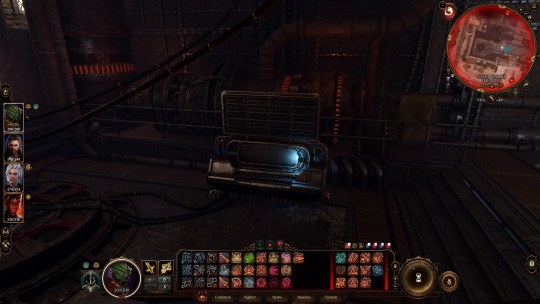
Wiring, pipes, cybernetics, glowing bulbs, spinny vaguely-dynamo-ish things ... while the vibe is all "dark and Satanic mills", it's also kind of turn-of-the-20th-Century too. This isn't medieval technology here. This is stuff that's not so far removed from what we use.
And interestingly, it's not just restricted entirely to this location, either. If you find your way into the Counting House vaults, you can find a note warning against using "devices powered by bottled lightning" inside the main vault, due to flooding. Bottled lightning - OK, so the bank apparently has power too! But then, the alarm systems in the main area do look suspiciously-electrical in some ways ... now, if only they could get their plumbing sorted out!
However, the pockets of semi-modern technology do seem to be quite localised. Most of what there is seems to be either highly-experimental (a powerful wizard's personal science project) or associated with powerful and wealthy institutions in the big city. And even there, the most advanced systems seem to be associated with the Gondians and their work. There also seems to be a suggestion that these innovations are quite new, and there doesn't seem to be have been many attempts to scale or mass-produce the equipment. The one exception to this pattern might be Reithwin, but the game strongly suggests that pre-curse Reithwin was a prosperous place, and on a main trade route to Baldur's Gate too, so it's entirely-plausible that the local elite might have been able to benefit from new ideas in the metropole. Perhaps the House of Healing in Reithwin was able to acquire a few very early prototypes from the Gondians' workshops, just before the curse fell? That could explain the elevator, and what I suspect are filament lamps?
As for the lack of wider advancement in Baldur's Gate itself, honestly I think we can pin the blame for this one directly on the city's horrifyingly-toxic politics. Gortash is a devotee of the God of Tyranny, so of course he doesn't want to share his toys. The city is allowed to have just enough advanced industry to support his plans for his dictatorship, but of course he's not going to share that power with the wider population! (The Counting House is presumably a special case for this rule - I wouldn't be surprised if there's quite a complex dynamic of power-balancing between Gortash and the financiers, but it is in his interests to share some things with "the money", if you will.)
Lastly, another factor might be that most of the actual R&D work seems to be happening either with the followers of specific gods - such as Gond! - or various wizards. What we see of their world is rather mixed - many wizards are awful (hi, Lorroakan!), though there are exceptions too (overall Rolan is, ultimately, a decent person). They don't seem to tend to work together, and as far as I've seen, there doesn't seem to be any equivalent of a university system or public education system. If a wizard dies, it seems quite possible their research might die with them, which is surely going to put a crimp on development! Meanwhile, with regards to the more "industrially-minded" gods like Gond, who knows how willing they are for their devotees to share their work widely? (Let's face it, a lot of Faerun's deities kinda suck - Gale has a point when he warns against seeking divine intervention, I think.)
Anyway, food for thought...
3 notes
·
View notes
Text

"Women on the banks of the Nile" by Emile Bernard, 1900
92 notes
·
View notes
Text
“Rules”: repost with the information of your muse, including headcanons, etc. If you fail to achieve some of the facts, feel free to add some other of your own! When you’re done, tag 15 other people to do the same!
tagged by: stolen :)
tagging: you. reading this.
B A S I C S
Name: Bagatella Ninette Azalaïs-Silva Fleur-de-Feu
Age: 12-14
Birthdate: March 20th
Species: Human(?) [yveltal "clone"]
Gender: Female
Orientation: girls prettie :)
Profession: " traveler "
P H Y S I C A L A S P E C T S
Hair: Teal, the left side grows faster than the right. Originally was white, though at a point started to darken and gain the teal hue it's known for. Over all thick and extremely soft, easy to tangle.
Eyes: Unblinking, bright, amber eyes. Described as "sun-trapped" or "burning". White pupils. Lost her left eye in an accident. Doesn't technically need to blink, used to sleep with her eyes open. Presently only does that sometimes.
Skin: Dark freckled skin, rough around her palms and feet. Parts of her skin are grey with red streaks--"scars"--which feel like a mix of leather and feathers, extremely soft on these parts.
Height: 6'0" [6'2" with heels]
Weight: Surprising light despite her height and muscle mass. 136 Ibs.
F A M I L Y
Siblings: Ruby ( @/ardynzunia ; adopted brother ), Marcellus ( @/sensoryled ; "brother"ish ), Arven ( @/herbacious-mystica ; not-brother )
Parents: Bagatella Amil ( bio father ), Andre Lacroid ( bio mother ), Lysandre ( @/flarefeu ; adopted father )
Grandparents: Deceased.
Other Relatives: Ingo ( @/cllaboard ; train ), Bagatella Vasil ( @/hardjinnger ; ancestor ), Siebold ( @/tumblestones ; possibly distantly related ), Viola ( possibly distantly related ), Alexa ( possibly distantly related )
Any Pets? None, if you could her pokemon, all her pokemon. If you called Silva's pokemon her 'pets', though, she would pummel you into a wall.
S K I L L S
Capable of talking to pokemon, capable of hearing hearts, capable of speaking to crystals as well as certain areas or "hotspots", extremely technologically intuitive, remarkably good at puzzle solving, physically closer to a pokemon's strength than a human's, capable of draining life from everything in a 10-20 feet radius around her if given the right conditions, proficient hunter, and near complete temperature resilience.
T R A I T S
—— positive ——
Extremely positive, quick thinking(in the right situations), hard-working, empathetic, comforting, will defend her friends(mostly).
—— negative ——
Ignorant, in denial, both grows attached, and is extremely distant, dishonest, toxic positivity.
L I K E S
Colors: Reds, blues, and golds/ambers.
Smells: Fire, "cold", burning wood, ash, snow, bird smell, sizzling meat.
Textures: Soft, feathers, cold things, hot things.
Drinks: Water. And coffee.
O T H E R D E T A I L S
Smokes?: No.
Drugs: No. Though "life energy" can act almost like a drug or put Silva in a temporary "high".
Driver License: No, but she's hotwired and driven many vehicles including cars.
Ever Been Arrested?: Nope! Almost :)
#study ;; beneath a piteous smile#verse ;; pokemon ;; beyond destructing and falling petals#maybe i'll do one for one piece verse eventually
6 notes
·
View notes
Text
RULES: repost with the information of your muse, including headcanons, etc. If you fail to achieve some of the facts, feel free to add some other of your own! When you’re done, tag 15 other people to do the same!

Tagged by: @ruinlost ( mwah mwah!!! thank you 🥺 )
Tagging: dangerous gun emoji in ur direction ... tag me this is a threat
B A S I C S
Name. Sylvie / Sylvatica / Foras
Age. 5000+
Birthdate. March 20th
Species. Elemental creature / god
Gender. Agender
Orientation. Demiromantic / Demisexual
Profession. Traveller for hire, freelancer
P H Y S I C A L A S P E C T S
Hair. Forest green, fading to a lime / light green gradient at the tips. Reaches to hips, though often held in a ponytail
Eyes. Forest green, with two light green rings around the pupil
Skin. Bronze / olive-toned
Height. 6'3" / 192 cm
Weight. 250 lbs. / 114 kg.
F A M I L Y
Siblings. None directly, though various other gods and non-humans might as well be considered their siblings
Parents. n/a
Grandparents.: n/a
Other Relatives. None directly, some people are considered to be adoptive children to them though
Any Pets?. n/a, any 'animal' companions they keep around are considered friends since they're also intelligent
Partners?. Zhongli
S K I L L S
Too many to count because of their age, some include: gardening, resin art, flower jewelry, wood carving, playing the tar, storytelling, cooking, sewing in many forms, making natural herb products ( medicines, hygiene products, etc ), and more
T R A I T S
—— Positive ——
Wise, charming, light-hearted, comedic, optimistic, laid-back
—— Negative ——
Reckless, stubborn, standoff-ish, immature, not serious, dramatic
L I K E S
Colors. Bright reds, deep greens, golds, whites, browns
Smells. Meat, floral scents, fresh dew, incense, lavender
Textures. Cotton, bumpy bark and rougher textures, soft silks, fur
Drinks. Warm coffee, lighter / fruitier wines, sweet drinks ( such as hot chocolate or fruit juice ), any type of tea
O T H E R D E T A I L S
Smokes. no, they do not enjoy it
Drugs. attempted, but with their body chemistry it doesn't work, so no point
Driver License. gained a glider license at some point, but they opt for on-foot travel
Ever Been Arrested. too many times to count, too many more times they haven't been. too many times bailed out as well. the millelith are unfortunately a bit familiar with them
6 notes
·
View notes
Text
“Rules”: repost with the information of your muse, including headcanons, etc. If you fail to achieve some of the facts, feel free to add some other of your own! When you’re done, tag 15 other people to do the same!
tagged by: snagged from like, half a dozen others
tagging: whoever wants it!
B A S I C S
Name: Alistair Hagen
Age: 21
Birthdate: March 20th
Species: Human
Gender: Cis Male
Orientation: Heterosexual
Profession: Former member of Team Snagem, Pokemon trainer.
P H Y S I C A L A S P E C T S
Hair: Red, almost always unkempt and left in a "bed hair" state.
Eyes: Red as red can be.
Skin: Extremely pale, sandblasted, the skin on his arms is practically painted with scars from a large number of sources.
Height: 5’7” (Claims vehemently to be 6'0)
Weight: Around 160 lbs
F A M I L Y
Siblings: Lili Hagen (Biological sister, estranged.) Larissa Hagen (Biological sister, estranged.)
Parents: Deceased
Grandparents: Very deceased
Other Relatives: N/A
Any Pets? His team of Pokemon!
S K I L L S
Pokemon battling, Mega evolution, Stone-carving, Stealing from others.
T R A I T S
STRENGTHS. Passionate, powerful, brave, resourceful, generally knows what he's doing, good judge of character.
WEAKNESSES. Loyal to a fault, unshakable guilty conscience, Asshole as a defence mechanism. Overconfidence.
L I K E S
Colors: Red, Brown, Burgandy.
Smells: Grass, the beach, flower fields, the open ocean.
Textures: fur, scales, silks.
Drinks: Energy drinks, more energy drinks and, you guessed it, even more energy drinks!
O T H E R D E T A I L S
Smokes?: Yes, to a concerning degree
Drugs: No
Driver License: No. He rides Flygon.
Ever Been Arrested?: Yes, handed himself over to the international police after fleeing Orre.
2 notes
·
View notes
Text

Norway confirms purchase of $500 million AMRAAM missiles for F-35 fleet
Fernando Valduga By Fernando Valduga 11/16/2022 - 14:00 in Armaments, Military
The Norwegian Ministry of Defense has concluded a contract worth five billion Norwegian kroner (approximately $502 million) for the purchase of advanced mid-range air-to-air missiles (AMRAAM) for its fleet of F-35 fighters.
The AIM-120D3 (AMRAAM-D) is an updated version of the missiles that were previously used by Norwegian F-16 fighters and the NASAMS air defense system.
With a more powerful engine, better control systems and data link, the missile will give Norwegian combat aircraft a better ability to combat the breadth of modern air threats.
“The F-35 is equipped with sensors that can find many more types of threats at much greater distances than before. Through this acquisition, the planes get a weapon that also presents great improvements in sensors and range, and that will be effective against everything from drones and cruise missiles to other combat aircraft," said the head of Norwegian defense purchases, Gro Jaere.
According to the defense ministry, the missiles will be delivered by 2028 as part of the program to acquire a total of 52 F-35 fighters.
The AMRAAM-D will be the main weapon that Norway's new combat plane will use to defend Norwegian airspace for several decades. The purchase of air-to-air missiles is the largest individual acquisition of weapons for the Norwegian Armed Forces of all time.
In use by 41 nations, AMRAAM is flying in the F-15C Eagle and F-15E Strike Eagle, F-16 Fighting Falcon, F/A-18 C/D Hornet and F/A-18E/F Super Hornet, F-22 Raptor, Eurofighter Typhoon, JAS39 Gripen, Panavia Tornado and Harrier. It is also the only qualified air-to-air missile in the F-35 Joint Strike Fighter.
The defense ministry said it also signed an industrial cooperation agreement with missile manufacturer Raytheon, which already maintains close cooperation with several Norwegian defense companies.
"It is important for the government that large foreign defense acquisitions also create opportunities for Norwegian industry, and this is no exception. We see several relevant areas of cooperation that, together, can guarantee the creation of value in the value of several billion crowns," commented Defense Minister Bjorn Arild Gram.
Norway announced the purchase of AMRAAM after revealing its intention to acquire the new U.S. Air Force StormBreaker bombs for the F-35. Also built by Raytheon, the bomb carries a 105-pound ward and uses a combination of active millimeter wave radar finder, semi-active laser orientation, infrared finder and GPS-coupled inertial orientation and data link to hit stationary targets at 69 miles and moving targets at 45 miles.
Tags: AIM-120 AMRAAMMilitary AviationF-35 Lightning IIRaytheonRNAF - Royal Norwegian Air Force / Royal Norwegian Air Force
Previous news
Air carrier São Paulo is prohibited from dooting in the Port of Suape
Fernando Valduga
Fernando Valduga
Aviation photographer and pilot since 1992, he has participated in several events and air operations, such as Cruzex, AirVenture, Dayton Airshow and FIDAE. It has works published in specialized aviation magazines in Brazil and abroad. Uses Canon equipment during his photographic work in the world of aviation.
Related news
HELICOPTERS
VIDEO: Sikorsky and DARPA successfully conduct autonomous rescue operation using Black Hawk without pilot
16/11/2022 - 12:00
MILITARY
Russian missiles fall in Poland killing at least two civilians
16/11/2022 - 08:32
MILITARY
VIDEO: F-117 "Dark Angel" goes by highway to museum in Arizona
15/11/2022 - 17:46
The Netherlands is one of the eight NATO countries that operate Chinook.
HELICOPTERS
Boeing delivers the 20th and last CH-47F Chinook to the Royal Air Force of the Netherlands
15/11/2022 - 16:00
Premium Aerotec completed and delivered the first central part of the hull to a Eurofighter of the Quadriga contract. (Photo: Premium AEROTEC/Jost G. Thorau)
MILITARY
First centerpiece of the fuselage delivered to the "Quadriga" Eurofighter
15/11/2022 - 14:00
MILITARY
IMAGES: Airbus retires its oldest A400M
15/11/2022 - 12:22
home Main Page Editorials INFORMATION events Cooperate Specialities advertise about
Cavok Brazil - Digital Tchê Web Creation
Commercial
Executive
Helicopters
HISTORY
Military
Brazilian Air Force
Space
Specialities
Cavok Brazil - Digital Tchê Web Creation
2 notes
·
View notes
Text
Hakeem Jones.
001. SHORT INTRO

🏘️ l o c a l

🏘️ guess who i just saw at ELMERTON TELEVISION STATION? HAKEEM JONES! don’t they look good for 42 years old? they have lived here for ALL THEIR LIFE and ARE a FREELANCE WRITER. they view the increase in tourism as NEGATIVE.
002. STATISTICS
Full Name: Hakeem Orion Jones
Age: 42
Birthdate: December 20th 1979
Zodiac Sign: Sagittarius
Gender: Male
Pronouns: he/him
Sexual Orientation: Demisexual
Romantic Orientation: Demiromantic
Marital Status: Married
Ethnicity: African-American
Nationality: American
Religious Identity: Agnostic (raised Christian, prev. non-practicing)
Positive Traits: Optimistic, Generous, Passionate
Negative Traits: Obstinate, Jealous, Cynical
003. BIOGRAPHY
Hakeem Orion Jones was born and raised in the coastal town of Elmerton, Florida. The Jones’ run a very successful bakery café chain called ‘King of Cakes’. The business has been in the Jones’ family for generations. Unlike his older sibling Jaylen, Hakeem was not looking forward to joining the Jones clan in the family business. Hakeem never liked cooking and baking, he tried, but wasn’t exactly good at it, nor did he particularly want to put in the effort to learn. His pursuits were more along the lines of being creative; Hakeem preferred to read, write, and dance while growing up. Out of the two siblings, Hakeem was more the artsy type while Jaylen thrived in the kitchen.
To support their baking prodigy, the Jones’s sent Jaylen off to earn their Baking & Pastry Arts Degree at one of the best Culinary Institutions in America. Meanwhile, Hakeem didn’t get to chase his dreams of becoming a writer, and instead went off to college to earn a business degree so he could still be a part of the family business, even if it wasn’t in the kitchen. It was a practical move on his parents' part, because they saw his passion for writing as more of a hobby, than an actual career path. Though a couple of years separated Hakeem and Jaylen the siblings have always been close and supportive of each other. Family comes first is definitely a mantra within the Jones’ household. Naturally, after completing their educational pursuits, Hakeem and Jaylen returned to Elmerton and worked alongside their family at King of Cakes. Jaylen dabbled in many cake baking and artistry competitions, the most prolific of the lot was them winning Food Network’s Cake Wars. The siblings used the prize money to diversify ‘King of Cakes’. Now, customers have the opportunity to order personalised cakes for events, and enroll in baking and cake decorating classes taught by the staff.
Hakeem never was truly able to escape the call of his writing muse. He would still fill his free time with it at any related activity whenever he could. One day he hoped that one of his stories would be shared with the world. Luckily for him, that opportunity came in his late twenties. By then Hakeem had fallen for, and married his best friend, and if it wasn’t for her supporting him, he might have never become a best selling author. Hakeem quit his job, and found his niche in the writing world where he made a name for himself as a Romance Novelist. While he adored writing for that genre, there were other things he wanted to explore as well; the world, for example. Hakeem and his wife started travelling for vacation purposes, and naturally, he decided to document their experiences with a travel blog. Once paired with their couple travel Instagram, those vacations became more frequent, and sponsored by various stakeholders. Hakeem never thought he’d be paid to travel and write about it, but that’s what he and his wife were doing up until a year ago.
The accident that nearly ended his wife’s life was the fault of a tourist visiting Elmerton. The driver was drunk and speeding which was a recipe for disaster. Unfortunately Hakeem was on the phone with her, and heard everything up until the call abruptly disconnected. One minute they were bantering, and making dinner plans, and in the next, soul crushing pain. If it wasn’t for the pregnancy that surprised them, the couple would have been jet setting as per usual. In the weeks prior to the accident they received the shocking news. His vasectomy was just the year before, the chances were ridiculous that they would have been that 1 in 1000 to get pregnant, yet it happened. With doubts cast aside they came around to the idea of welcoming a baby into their lives. Since then, things have never been the same.
004. EXTRAS
Subplot: the day i (didn’t) lose you - MUSE AK
3 notes
·
View notes
Text
characteristics of tragedy
tragedy, branch of drama that treats in a serious and dignified style the sorrowful or terrible events encountered or caused by a heroic individual. By extension the term may be applied to other literary works, such as the novel.
Although the word tragedy is often used loosely to describe any sort of disaster or misfortune, it more precisely refers to a work of art that probes with high seriousness questions concerning the role of man in the universe. The Greeks of Attica, the ancient state whose chief city was Athens, first used the word in the 5th century BCE to describe a specific kind of play, which was presented at festivals in Greece. Sponsored by the local governments, these plays were attended by the entire community, a small admission fee being provided by the state for those who could not afford it themselves. The atmosphere surrounding the performances was more like that of a religious ceremony than entertainment. There were altars to the gods, with priests in attendance, and the subjects of the tragedies were the misfortunes of the heroes of legend, religious myth, and history. Most of the material was derived from the works of Homer and was common knowledge in the Greek communities. So powerful were the achievements of the three greatest Greek dramatists—Aeschylus (525–456 BCE), Sophocles (c. 496–406 BCE), and Euripides (c. 480–406 BCE)—that the word they first used for their plays survived and came to describe a literary genre that, in spite of many transformations and lapses, has proved its viability through 25 centuries.
Historically, tragedy of a high order has been created in only four periods and locales: Attica, in Greece, in the 5th century BCE; England in the reigns of Elizabeth I and James I, from 1558 to 1625; 17th-century France; and Europe and America during the second half of the 19th century and the first half of the 20th. Each period saw the development of a special orientation and emphasis, a characteristic style of theatre. In the modern period, roughly from the middle of the 19th century, the idea of tragedy found embodiment in the collateral form of the novel.
This article focusses primarily on the development of tragedy as a literary genre. For information on the relationship of tragedy to other types of drama, see dramatic literature. The role of tragedy in the growth of theatre is discussed in Western theatre.
Development
Origins in Greece
The questions of how and why tragedy came into being and of the bearing of its origins on its development in subsequent ages and cultures have been investigated by historians, philologists, archaeologists, and anthropologists with results that are suggestive but conjectural. Even the etymology of the word tragedy is far from established. The most generally accepted source is the Greek tragōidia, or “goat-song,” from tragos (“goat”) and aeidein (“to sing”). The word could have referred either to the prize, a goat, that was awarded to the dramatists whose plays won the earliest competitions or to the dress (goat skins) of the performers, or to the goat that was sacrificed in the rituals from which tragedy developed.'
In these communal celebrations, a choric dance may have been the first formal element and perhaps for centuries was the principal element. A speaker was later introduced into the ritual, in all likelihood as an extension of the role of the priest, and dialogue was established between him and the dancers, who became the chorus in the Athenian drama. Aeschylus is usually regarded as the one who, realizing the dramatic possibilities of the dialogue, first added a second speaker and thus invented the form of tragedy. That so sophisticated a form could have been fully developed by a single artist, however, is scarcely credible. Hundreds of early tragedies have been lost, including some by Aeschylus himself. Of some 90 plays attributed to him, only seven have survived.
Four Dionysia, or Bacchanalia, feasts of the Greek god Dionysus (Bacchus), were held annually in Athens. Since Dionysus once held place as the god of vegetation and the vine, and the goat was believed sacred to him, it has been conjectured that tragedy originated in fertility feasts to commemorate the harvest and the vintage and the associated ideas of the death and renewal of life. The purpose of such rituals is to exercise some influence over these vital forces. Whatever the original religious connections of tragedy may have been, two elements have never entirely been lost: (1) its high seriousness, befitting matters in which survival is at issue and (2) its involvement of the entire community in matters of ultimate and common concern. When either of these elements diminishes, when the form is overmixed with satiric, comic, or sentimental elements, or when the theatre of concern succumbs to the theatre of entertainment, then tragedy falls from its high estate and is on its way to becoming something else.
As the Greeks developed it, the tragic form, more than any other, raised questions about human existence. Why must humans suffer? Why must humans be forever torn between the seeming irreconcilable forces of good and evil, freedom and necessity, truth and deceit? Are the causes of suffering outside of oneself, in blind chance, in the evil designs of others, in the malice of the gods? Are its causes internal, and does one bring suffering upon oneself through arrogance, infatuation, or the tendency to overreach? Why is justice so elusive?
Aeschylus: the first great tragedian
It is this last question that Aeschylus asks most insistently in his two most famous works, the Oresteia (a trilogy comprising Agamemnon, Choephoroi, and Eumenides) and Prometheus Bound (the first part of a trilogy of which the last two parts have been lost): Is it right that Orestes, a young man in no way responsible for his situation, should be commanded by a god, in the name of justice, to avenge his father by murdering his mother? Is there no other way out of his dilemma than through the ancient code of blood revenge, which will only compound the dilemma? Again: Was it right that Prometheus, in befriending humankind with the gifts of fire and the arts, should offend the presiding god Zeus and himself be horribly punished? Aeschylus opened questions whose answers in the Homeric stories had been taken for granted. In Homer, Orestes’ patricide is regarded as an act of filial piety, and Prometheus’s punishment is merely the inevitable consequence of defying the reigning deity. All of the materials of tragedy, all of its cruelty, loss, and suffering, are present in Homer and the ancient myths but are dealt with as absolutes—self-sufficient and without the questioning spirit that was necessary to raise them to the level of tragedy. It remained for Aeschylus and his fellow tragedians first to treat these “absolutes” critically and creatively in sustained dramatic form. They were true explorers of the human spirit.
3 notes
·
View notes
Photo

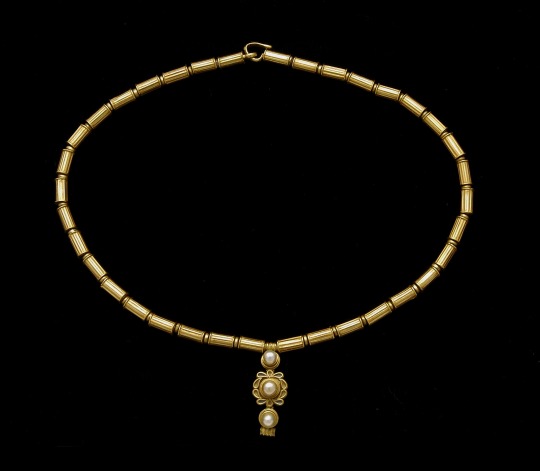
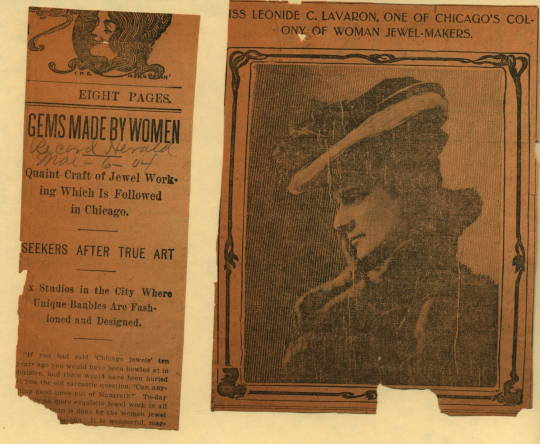
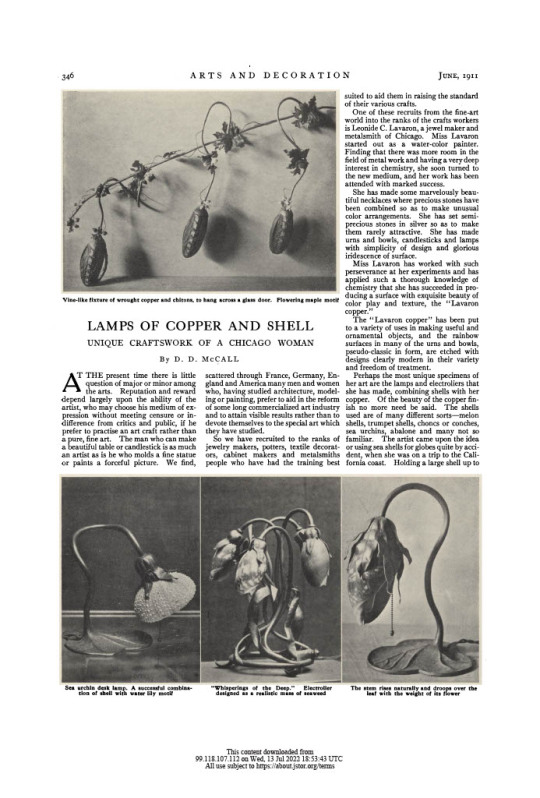
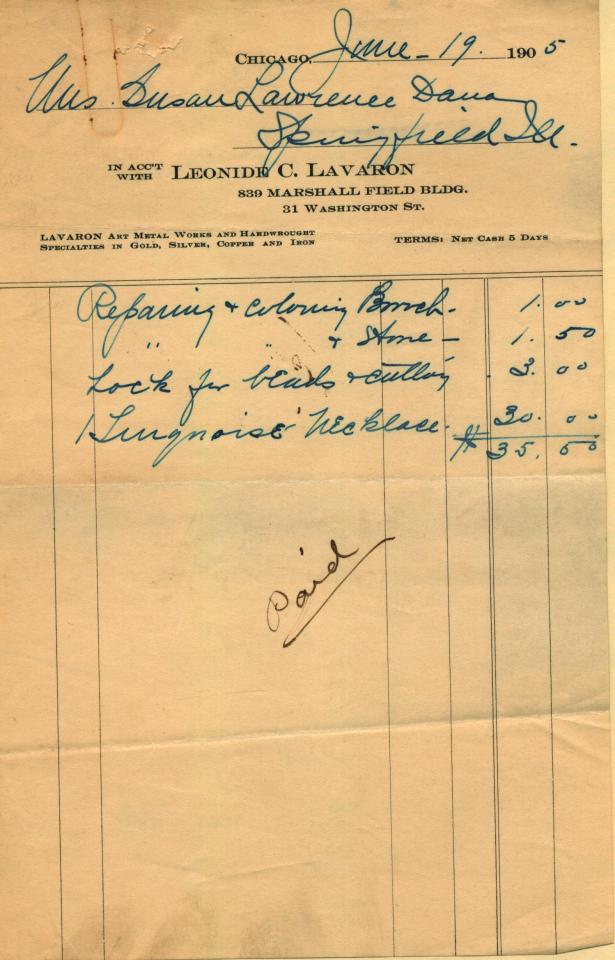
Arts and Crafts Jewelry in Chicago
As the 18th century progressed towards the 20th, artists and designers of the Arts and Crafts and Art Nouveau movements continued to look for new ways, new forms, and new materials to express their ideas about modern arts for a modern world.
Because jewelry in particular, and metalsmithing in general, had long associations with established wealth, tradition, and luxury, it was not an immediate choice of medium for artists looking to question exactly these establishments. However, as the 19th century progressed, fashionable women increasingly began to reject the diamonds, rubies, sapphires, and gold of their mothers and grandmothers in favor new kinds of jewelry inspired by nature, and the arts of the “Orient” or Medieval and Renaissance Europe.
The best known of these new jewelers was Renee Lalique, a French jeweler and goldsmith. Influenced by the Japanese art that so fascinated French artists and intellectuals of the time, Lalique’s designs featured the Art Nouveau’s characteristic sinuous, whiplash line, combined with flowers, insects, and nymph-like female forms. These delicate, organic designs rejected the traditional hierarchy of “precious” and “semi precious” gems, using instead horn, glass, opals, moonstone, and enamels to create soft, shimmering plays of color and light in jewelry who’s value was to be found in its artistic merit, not the inherent preciousness of its materials.
The Arts and Crafts movement also included jewelers and metalsmiths in its number. Like those of Art Nouveau, they often looked to nature for their inspiration, but they generally tended to look back, to the Medieval and Renaissance workshops, rather than East towards Japan. They saw the Medieval guild as the ideal form of labor organization, and workshop style hand work as the ideal form of that labor. Like Art Nouveau, Arts and Crafts jewelry emphasized the value of the art over the preciousness of the materials. It too favored the soft, shifting colors of gems like moonstone and opal, but tended to put more focus on worked metal, particularly copper and silver.
Like most major cities even today, Chicago at the Turn of the Century had a major jewelry industry, which provided a home not only for jewelers working with traditional forms and precious materials, but also the avant garde Arts and Crafts styles. As an article from the 1904 Record Herald indicates, the Chicago Arts and Crafts Society hosted a number of, notably, women jewelers. As jewelry was traditionally a masculine profession, the gender of these jewelers was of particular interest.
The article names these women as Madeline Yale Wynne, Florence H Koehler, Leonide C. Lavaron, Jessie M Preston, Christia Reade and Hannah Beye. All of these women are and were influential artists in the Arts and Crafts movement, and many of them were also active in the women’s suffrage movement.
However, Leonide Lavaron is of particular interest to us for the purposes of this article. Leonide Lavaron was born in New York to French parents. As a child, her family moved to Chicago, and after finishing her general education in the public schools, she chose to study art. A gifted chemist, she produced a treatment that produced an iridescent effect on copper, which came to be know as Lavaron Copper, and was often described as a revival of an ancient Egyptian technique.
The same Record Herald article that discusses Chicago’s women jewelers also mentions some of the prominent women that purchased it, including Susan Lawrence Dana. Dana is described as having purchased “An iridescent copper belt, the wrought links of which show infinite labor, and who’s green and gold coloring is enhanced by the chrysophases with which it is set, a rose gold ring set with a cabochon sapphire and olivines, and a set of iridescent copper buttons with turquoises…” Additionally, the Dana-Thomas House Foundation has a number of receipts for purchases or repair work from Leonide Lavaron, dating to as late as 1908.
Image 1: Bodice Ornament, Renee Lalique, 1903-04, glass, horn, citrine.Renee Lalique is one of the best know Art Nouveau jewelers. His work reflects the fluid, organic lines and natural influences of Art Nouveau, and focuses on the artistic, rather than material value of its components, frequently using non precious materials such as glass and horn. Image Credit: The Victoria and Albert Museum.
Image 2: Florence Koehler, Necklace/bracelet, ca.1905-1935, enameled gold, pearl.Like many artists in the Arts and Crafts Movement, Florence Koehler rejected mechanical, industrial models of production and contemporary ideas of what jewelry should look like in favor drawing inspiration from Medieval and Renaissance jewelry. Koehler modeled her studio practices after these historic workshop styles of production, and preferred the soft, shifting colors of moonstone, pearl and enamel over the hard shine of diamonds or polished gold. She often enameled over gold to give it a softer look. Photo Credit: The Smithsonian American Art Museum.
Image 3: “Gems Made By Women”, Record Herald, March, 6, 1904. Susan Lawrence Dana Papers, B3 Sxiii F2.Featuring an image of Leonide C. Lavaron, this article discusses several well known female jewelers and metalsmiths working in the Arts and Crafts tradition in Chicago at the Turn of the Century. It also mentions some of the wealthy women who purchased this jewelry, including Susan Lawrence Dana, who bought a number of pieces from Lavaron. Photo Credit: The Dana-Thomas House Foundation.
Image 4: “Lamps of Copper and Shell:Unique Craftwork of a Chicago Woman”, D.D. McCall, Arts and Decoration (1910-1918), June, 1911, Vol. 1, No. 8, PP. 346-347. Leonide C. Lavaron was one of several Chicago women making jewelry and metalwork in the Arts and Crafts style in Turn of the Century Chicago. She was particularly known for her copper work and chemistry knowledge, and developed an iridescent patina that came to be known as Lavaron Copper. Image Credit: Jstor.
Image 5: Receipt for Jewelry and Repair Work from Leonide C. Lavaron, June 19,1905, Susan Lawrence Dana Papers B3 Sxiii F2.Susan Lawrence Dana bought several pieces from Lavaron at her shop in the Marshall Field Building. In addition to the pieces described in the Record Herald article, several receipts for purchases and repair work dating from 1905 to 1908 are known to exist in the Susan Lawrence Dana Papers. Photo Credit: The Dana-Thomas House Foundation.
#art history#art nouveau#Arts and Crafts#chicago#chicago art#women artists#Metalworking#jewelry#chicago history#women history
5 notes
·
View notes